With education as our focus here at The Best Colleges, we obviously love libraries. College libraries, public libraries, private libraries — whatever and wherever they are, we love them all. For those of you not "of a certain age," a library is a quiet building that houses tons of books and reference materials, typically dating back to Ye Olde Pre-Internet Times. We may not be as reliant on brick-and-mortar libraries anymore, but even in the digital era, we had no trouble finding dozens of architecturally interesting libraries and libraries with interesting collections, as well as many that are actually fascinating in both respects. We'd love to spend a day in any of these libraries catching up on our reading and enjoying the sanctuary-esque vibes. The following 35 are libraries that we thought deserved a closer look — we hope you'll agree!
1. Library of Congress — Washington D.C., USA

The Library of Congress in Washington DC is essentially both the national library of the U.S. and the country's oldest federal cultural institution. Though it consists of only three buildings, it is the largest library in the world for shelf space and number of volumes. While open to the public for on-site research and as a tourist attraction, as the research institution of Congress, only members of Congress, Supreme Court justices, and other specified government officials can check out books. The library is formally known as the "library of last resort" in the U.S., charged with making certain items available to other national libraries if all other means have been exhausted. The library's holdings are vast, including more than 32 million books, more than 61 million manuscripts, a rough draft of the Declaration of Independence, one of only four perfect vellum copies of the Gutenberg Bible in the world, over one million newspapers from the last three centuries, over five million maps, six million pieces of sheet music, and more than 14 millions photos and prints.
2. Bodleian Library — Oxford, United Kingdom
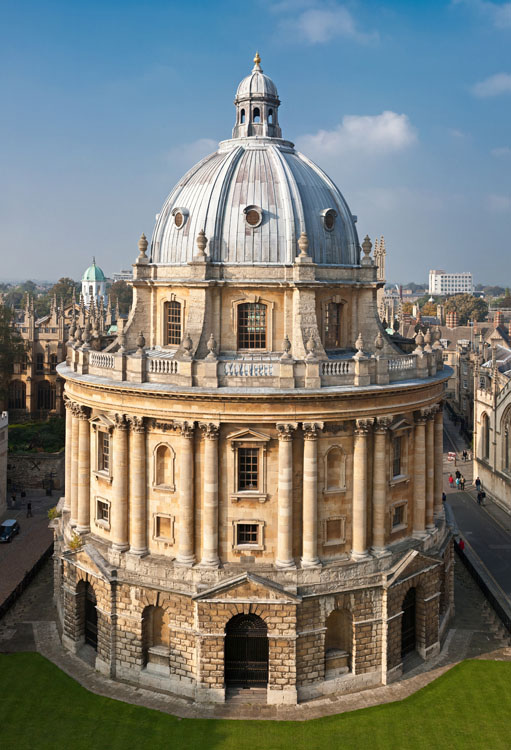
Established in 1602 as Oxford University's library, Bodleian is one of the oldest libraries in Europe. The library houses more than 11 million items, including many of historical importance: four copies of the Magna Carta, a Gutenberg Bible, and Shakespeare's First Folio (from 1623), just to name a few. Though Bodleian comprises multiple buildings, perhaps the most visually interesting is Radcliffe Camera, built in 1737-1749 to house the Radcliffe Science Library. The earliest circular library in England, Radcliffe has outlasted its 15 minutes of fame by appearing in multiple films, including Young Sherlock Holmes, The Saint, The Red Violin, and The Golden Compass.
3. Reading Room at the British Museum — London, England

The Reading Room at the British Museum is located in the center of the Museum's Great Court. The building's domed exterior protects a unique interior ceiling made of a special kind of papier-mache, which is another first on our list! For much of the Room's history, access was limited to registered researchers, attracting notable visitors including Karl Marx, Oscar Wilde, Mahatma Gandhi, Rudyard Kipling, George Orwell, Mark Twain, Lenin, and H.G. Wells during this time. The majority of the collection was moved to the new British Library in 2000; the Reading Room now houses an information center and a curated collection of specialty art and history titles relevant to the collections of the British Museum. The Reading Room has also been known to host long-running temporary exhibitions of its own, such as the 2006 exhibit centered on China's famous Terracotta Army.
4. Yale University Beinecke Rare Book and Manuscript Library — New Haven, Connecticut, USA
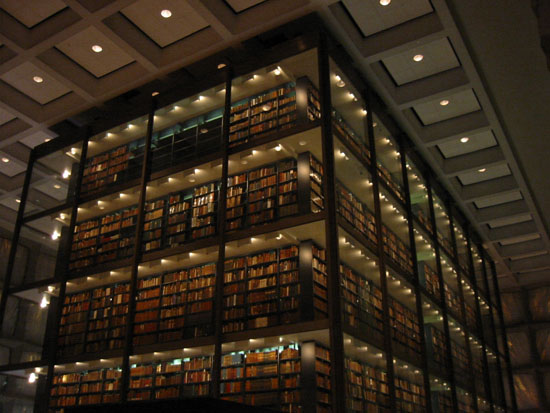
The Yale University Beinecke Rare Book and Manuscript Library holds the distinction of being the largest building in the world that serves the express purpose of preserving rare books and manuscripts, which alone undoubtedly makes it one of the best libraries in the world. The library's impressive holdings celebrate significant authors like Rudyard Kipling, D.H. Lawrence, Sinclair Lewis, and Joseph Conrad through its special collections. Beinecke's central shelving area includes glass walls and soft lighting to protect the works from direct light. Accessible to the public as a tourist attraction, the library's exhibition hall displays many of the library's rare works, including one of only 48 copies in existence of a treasured Gutenberg Bible.
5. Vatican Library — Vatican City, Rome
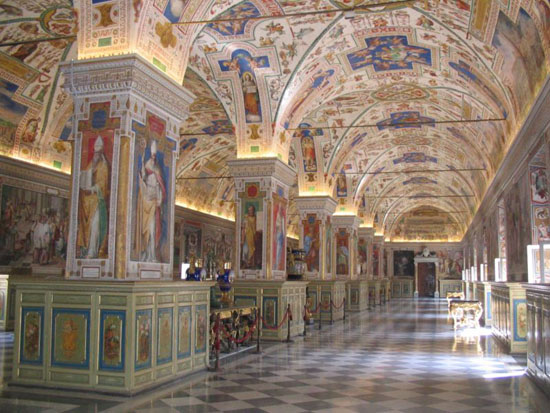
The Vatican Library, under the ecclesiastical jurisdiction of the Catholic Church in Rome, is one of the oldest libraries in the world. Though it was formally established in 1475, its existence in early forms dates back to the origins of the Catholic Church. For nearly 600 years, the library has added to its collection through historic acquisitions, generous bequests, and gracious gifts. The Vatican Library currently holds mor than 1.1 million books, 75,000 manuscripts, and over 8,500 incunabula. Fittingly, the library owns the oldest complete manuscript of the Bible, as well as many other significant works from medieval times.
6. National Library of St. Mark's — Venice, Italy
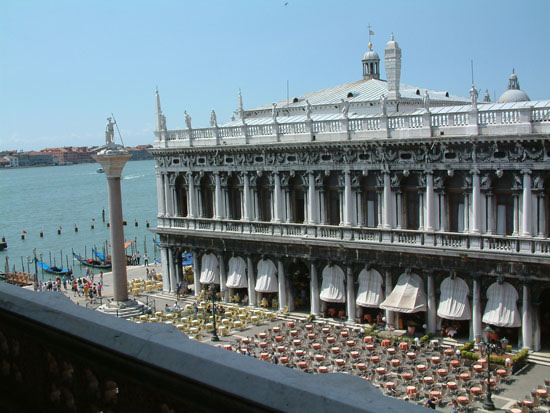
Fittingly housed in a Renaissance building in Venice, the National Library of St. Mark's contains one of the most important collections of classical texts in the world. Though its lengthy construction period would not begin until 1537, collecting for the library began as early as 1468 with a gift from Cardinal Bessarion of 250 manuscripts and 750 codices. As of 1603, a law was enacted that required one copy of all books printed in Venice to be housed at the National Library. Today, the collection encompasses more than a million books, over 13,000 manuscripts, 2,883 incunabula, and more than 24,000 16th-century works.
7. Boston Public Library — Boston, Massachusetts, USA
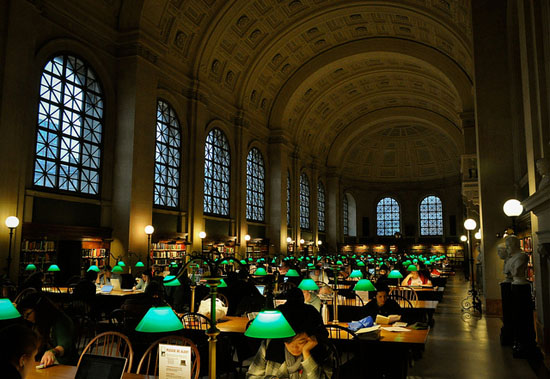
Established in 1848, Boston Public Library was the first publicly supported library in the United States and, with its present collection of 22 million items, also the second-largest. The Central Library consists of two buildings, the Johnson Building and the McKim Building, which houses the library's research collection and exhibitions. Built in 1895, McKim contains many beautiful murals, including Edward Abbey's famous scene depicting the legend of the Holy Grail. The main room of the McKim building — Bates Hall — also features a unique coffered ceiling. More than 1.7 million rarities are included in the research collection at McKim, including medieval manuscripts, incunabula, early Shakespeare that includes a First Folio, colonial Boston records, and a major Daniel Defoe collection. The collection is also home to the libraries of several notable figures in American history, including John Adams, William Lloyd Garrison, and Nathaniel Bowditch.
8. Library of Parliament — Ottawa, Canada
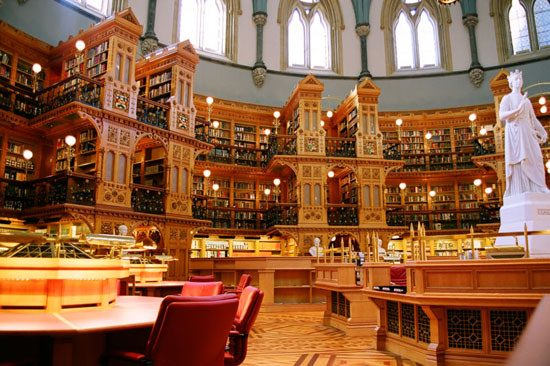
The Library of Parliament in Ottawa, Canada holds a special distinction on our list, as it is the only library of such prominence that its likeness is printed on the country's currency (it is featured on Canada's ten dollar bill). The design of this national landmark was inspired by the British Museum Reading Room, and includes walls supported by 16 flying buttresses, a vaulted ceiling in the main reading room, and white pine paneling with beautifully detailed carvings of flowers, masks, and mythical creatures. The collection encompasses more than 600,000 items, which is curated by a dedicated 300-member staff. While access to the facility is generally restricted to Canadian parliamentary business, tours are often made available to the public.
9. New York Public Library — New York, New York, USA
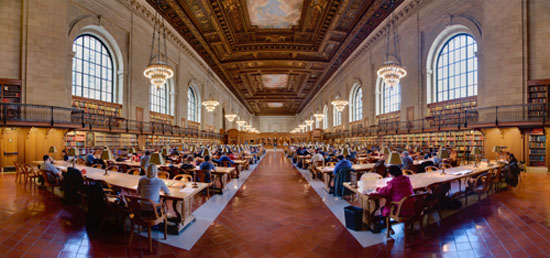
The New York Public Library is awe-inspiring for its scope and breadth. As the third largest library in North America with more than 50 million items in its collection, it encompasses 87 libraries serving 3.5 million people across the state. The Rose Main Reading Room acts as the centerpiece of the library, with grand arched windows along its 52-foot walls, and also featuring chandeliers and a gilded and painted ceiling. The library acquired America's first Gutenberg Bible, and also houses collections with a special emphasis on Americana literature and printed materials. Among the most recognizable sites on our list, the library has made multiple appearances in feature films, as a key setting in the film The Day After Tomorrow and as a prominent backdrop in the original Ghostbusters, among others.
10. Thomas Fisher Rare Book Library — Toronto, Canada
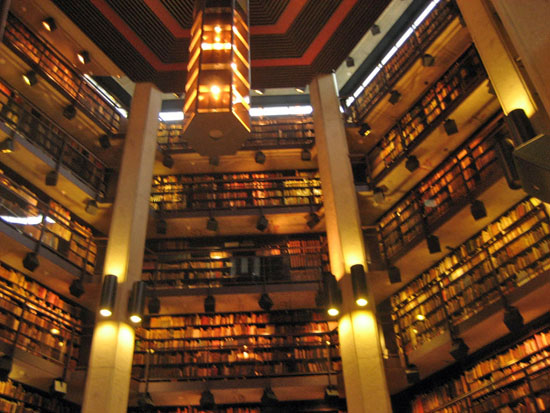
Affiliated with the University of Toronto, the Thomas Fisher Rare Book Library houses more rare books than any other collection in Canada. The collection includes unique artifacts like Newton's Principia (1687), Shakespeare's First Folio, the Nuremberg Chronicle (1493), and a Babylonian cuneiform tablet dating to 1789 BC. Robert S. Kenny, a Communist Party of Canada member, also donated a large part of the collection. In all, the rare book library includes more than 25,000 items with a special focus in labor movements worldwide, though with a particular emphasis on Canada and its history.
11. Seattle Central Library — Seattle, Washington, USA
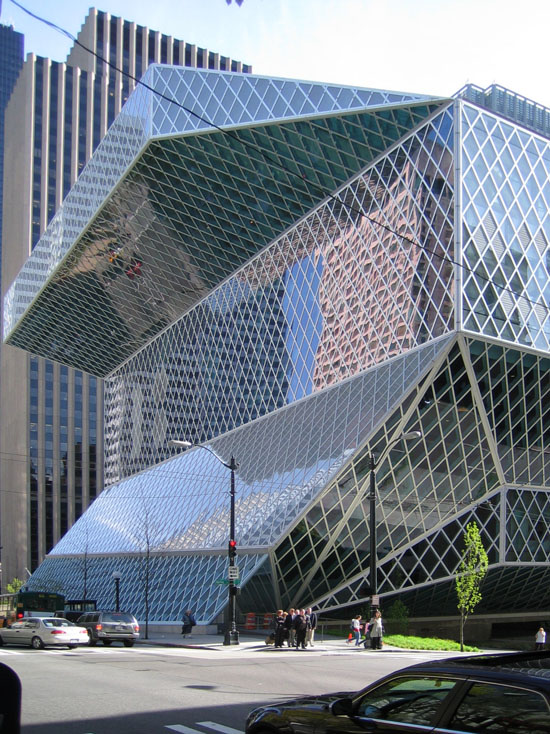
Unmistakably modern in a beautiful glass and steel design created by architects Rem Koolhaas and Joshua Prince-Ramus, the Seattle Central Library opened in Washington's largest city in 2004. With their contemporary design, the architects aimed to create an inviting open and airy space, challenging the popular perception of libraries as dark and stuffy. The library was built with the capacity to accommodate more than 1.45 million books and mixed media materials. By 2008, the library had finally completed a ten-year "Libraries for All" initiative, which was aimed at expanding library access to a broader range of Washingtonians. It was the most expensive renovation of its kind in history, eventually totaling more than $290 million for the project.
12. Abbey Library of Saint Gall — St. Gallen, Switzerland
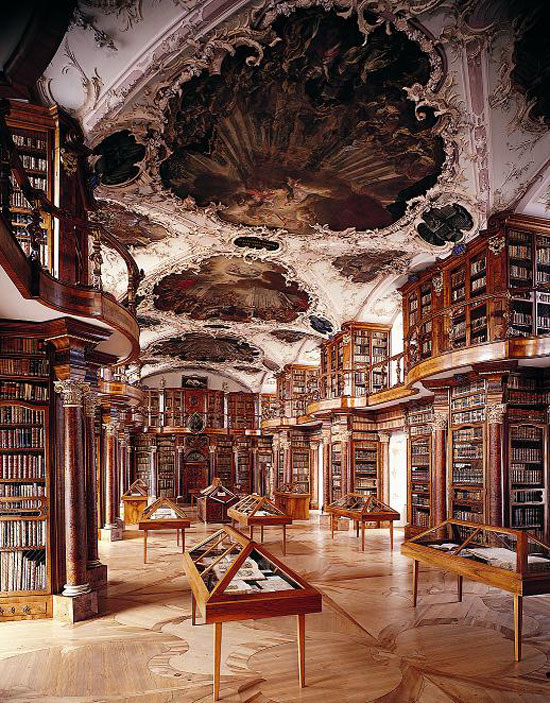
The Abbey Library of Saint Gall is the oldest library in Switzerland. The library's founder, Saint Othmar, is also credited with establishing an abbey of the same name in 719, known as one of the oldest monastery libraries in the world. Saint Gall is home to roughly 160,000 volumes, including manuscripts dating back to the 8th century. In 1983, the United Nations' Educational, Scientific, and Cultural Organization named the library a World Heritage site, calling it a "a perfect example of a great Carolingian monastery". The library offers online access to many of its holdings through an electronic database though, as a general rule, pre-1900 books can only be read on-site.
13. Austrian National Library — Vienna, Austria
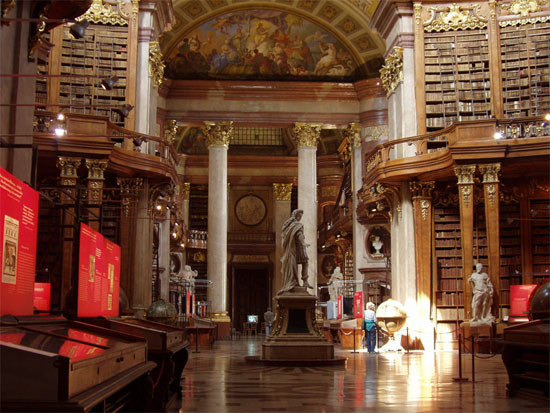
Much like the Library of Congress in the U.S., the Austrian National Library is responsible for managing the collection of all publications that appear in Austria. Works of special prominence include the world's foremost Globe collection, rare books dating from the 4th century, a UNESCO Memory of the World Programme item (the Vienna Dioscurides, a 6th-century illuminated manuscript exploring medicine and healing), and a map collection that dates back to the 16th century. Originally housed in the Prunksaal, the library is currently located at Hofburg Palace and the baroque Palais Mollard-Clary, housing 7.4 million items within its comprehensive collection.
14. National Library of Sweden — Stockholm, Sweden

The National Library of Sweden is responsible for preserving all Swedish printed and A/V material. Since the 1500s, there has been some form of National Library in Sweden, made possible initially through purchases of collections from Swedish monasteries that were later destroyed in the Reformation and, later still, via war spoils from the Thirty Years War. To supplement its holdings, the library obtained the Library of Würzburg and the Royal Library of Prague during The Thirty Years War, as well as obtained a 13th-century copy of the "Devil's Bible," which can be viewed online here. Today, Sweden's National Library holds more than 20 million objects.
15. Library of the Benedictine Monastery — Admont, Austria
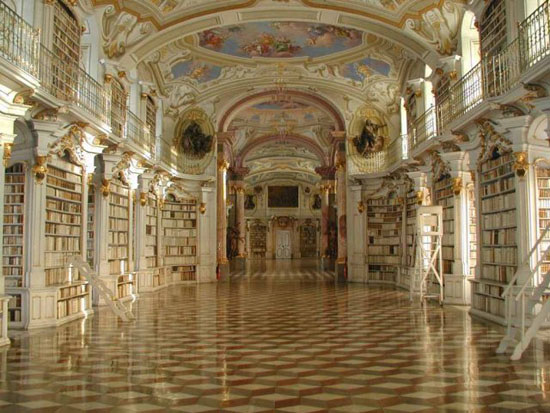
The Library of the Benedictine Monastery is the largest monastery library in the world. The library holds 70,000 volumes, including 1,400 manuscripts and 900 incunables. Some items in the library's collection were gifted by Archbishop Gebhard, who founded the monastery in 1074. As part of an overall design inspired by the Enlightenment, the ceiling of the library is decorated with seven cupolas, highlighting elaborate frescoes by Bartolomeo Altomonte that display the progression of human knowledge.
16. The Morgan Library & Museum — New York, New York, USA
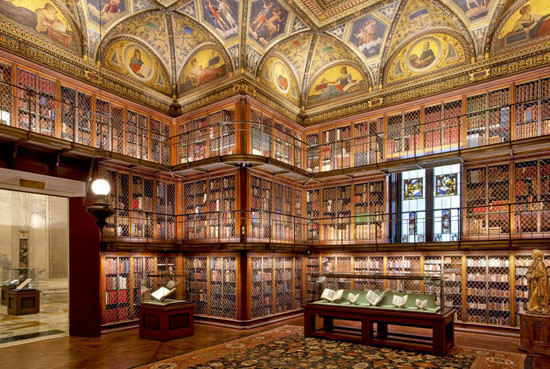
The Morgan Library & Museum was formed in 1906 to hold the private collection of banking magnate J.P. Morgan, including manuscripts, printed books, prints, and drawings. Items of special prominence in Morgan's collection include illuminated and original manuscripts, works by Sir Walter Scott and de Balzac, and drawings by masterful artists like Leonardo, Raphael, Picasso, Michelangelo, and Rembrandt. Interestingly, Morgan was apparently also drawn to unusual collectibles to add to his holdings, including scraps of paper written on by Bob Dylan for what would become "Blowin' in the Wind," concept drawings for Antoine de Saint-Exupéry's The Little Prince and a Charles Dickens manuscript of A Christmas Carol.
17. Jay Walker's Private Library — Ridgefield, Connecticut, USA
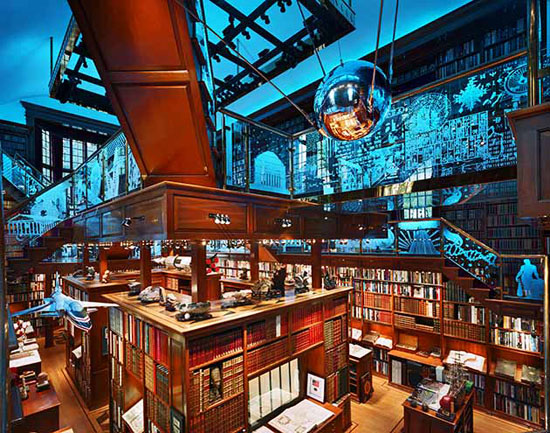
While we didn't expect to find a privately owned library worthy of our list, let's just say it was a pleasant surprise to learn that American inventor and entrepreneur Jay Walker used his wealth to develop a comprehensive private library. Christened "The Walker Library of the History of Human Imagination," the library located in Walker's Connecticut home has been called "the most amazing library in the world" by WIRED magazine as well as the subject of a TED Talk. The architecture incorporates a multi-level design inspired by the surreal works of M.C. Escher. It houses more than 50,000 books, including historic and museum-worthy manuscripts and publications. While the library is not open to the public, Walker has been known to host notable public figures at his home.
18. Trinity College Library — Dublin, Ireland
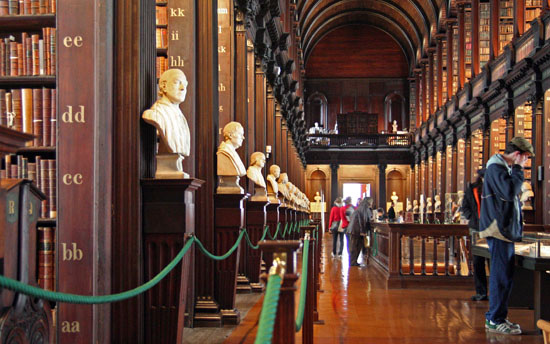
The Trinity College Library, fondly called the Long Room, is the largest library in Dublin, and responsible for many of the same functions for Ireland that the Library of Congress fulfills for the United States. Though the library actually consists of four separate buildings, the Old Library, built in 1592, is among Ireland's biggest tourist attractions, home to the historic Book of Kells, a Gospel book created by Celtic monks roughly around 800 AD. It is also home to six million other printed works, including manuscripts, music, journals, maps, and special collections.
19. Danish Royal Library — Copenhagen, Denmark

The Danish Royal Library is the national library of Denmark, founded in 1648 by King Frederik III. The library holds all works printed in Denmark since the 17th century and nearly every Danish book ever written, dating back to the first Danish book printed in 1482. The Danish Royal Library is the largest library among the Nordic countries. Many significant works, including the correspondence of Hans Christian Anderson and historical maps of the Polar Region, are held here. Holdings also include the Arnamagnæan Manuscript Collection, named for Icelandic scholar Arnas Magnæan, who dedicated much of his life collecting manuscripts from Iceland, Norway, Denmark, and Sweden until his death in 1730.
20. Melk Monastery Library — Melk, Austria
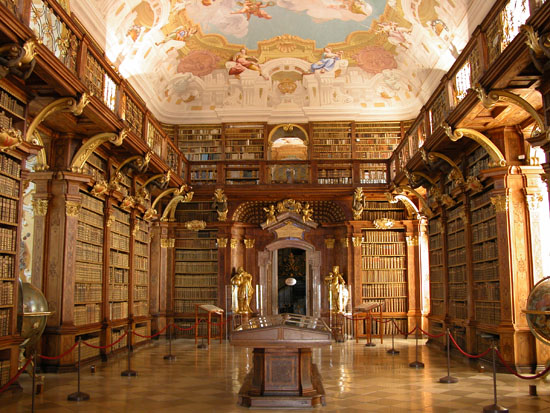
The formation in the 12th century of the Melk Monastery Library followed the founding of Melk Abbey and school of the same name around 1089. Word spread quickly, and the Melk Library became known as one of the largest manuscript holders in the world, also emerging as an authority in manuscript production. Today, the library's high ceilings, adorned with beautiful frescos painted by Paul Troger, guard what is still one of the world's biggest library when it comes to collections of medieval manuscripts, as well as a prominent collection of musical manuscripts.
21. Strahov Monastery Library — Prague, Czech Republic

Prague's Strahov Monastery Library is contained within the Strahov Monastery, founded in 1149. Segments of the library's interior include Theological Hall, built in 1679, and Philosophical Hall, completed in 1779. The monastery was transformed into the Museum of National Literature in 1950 after becoming occupied by the Communist government, though all was not lost; fortunately, the monastery and library were returned to the Premonstratensian order and the buildings restored when the Communist regime fell out of power in 1989. Today, it is one of the best libraries, holding more than 110,000 volumes, including over 1,200 incunabula.
22. Salt Lake City Public Library — Salt Lake City, Utah, USA
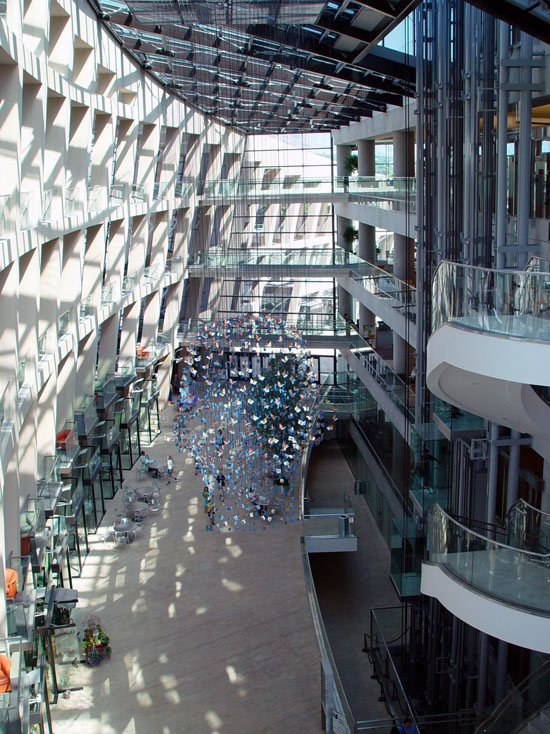
Constructed in 2003, the main location within Utah's Salt Lake City Public Library system is a unique building centered on a beautiful five-story curved glass wall and a 20,000-square-foot skylight, reinforcing the architect's commitment to incorporating natural lighting into the design scheme. The rooftop features spectacular views of Salt Lake City, and is adorned with landscaped gardens and grounds. With seven additional locations around Salt Lake City, the public library holds more than 500,000 books, e-books, and downloadable titles, as well as a large collection of zines and periodical publications.
23. State Library of Victoria — Melbourne, Australia
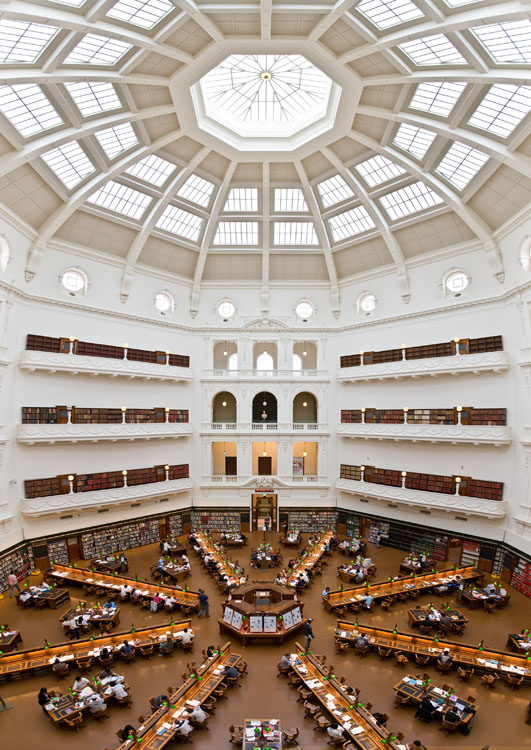
Founded in 1854, the State Library of Victoria now holds more than 1.5 million books, including special collections highlighting chess, the arts, the diaries of Melbourne's founders, and the folios of Captain James Cook. The centerpiece of the library is the LaTrobe Reading Room, a soaring octagonal space with the capacity to accommodate more than one million books and 500 researchers or readers in one sitting. At the time of its completion in 1913, the LaTrobe Reading Room was the largest dome in the world; today, it houses the library's extensive Australiana collection.
24. Château de Chantilly Library — Chantilly, France
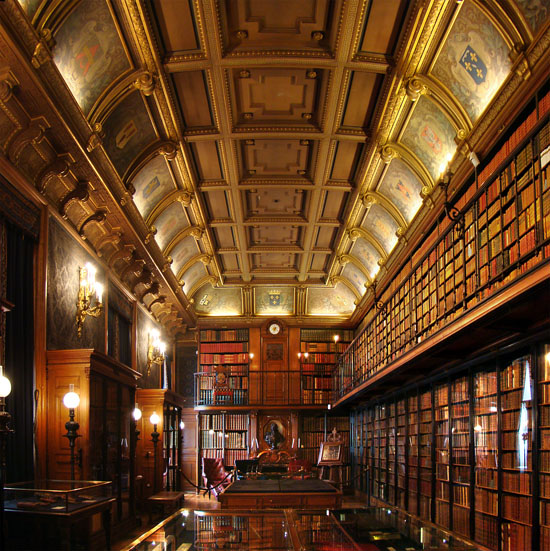
Among few libraries in Europe to hold a prized Gutenberg Bible in its collection, the Château de Chantilly Library is part of a French estate that also includes one of France's most important art galleries, the Musée Condé. The main part of the estate (Grand Château) was built in 1528-1531, with an additional annex (Petit Château) constructed in 1560. The Grand Château was destroyed during the French Revolution and was later rebuilt from the ground up between 1875 and 1881. The library of the estate contains more than 1,300 manuscripts and 12,500 printed works, including the aforementioned Gutenberg Bible (one of more than 700 incunabula, a term describing early printed books, typically before 1501,) and roughly 200 medieval manuscripts. The library is often open to the public for guided tours.
25. Wiblingen Monastery Library — Ulm, Germany

The Wiblingen Monastery was founded in 1093, and remodeled in the Baroque style decades later in the 18th century. The library is a favorite among art historians for its rich ornamentation and beautiful fresco ceiling. Inscribed at the entrance to Wiblingen is "In quo omnes thesauri sapientiae et scientiae," which means "In which are stored all treasures of knowledge and science," a fitting quote for such an historic European institution. Library archives hold a large collection of both Pagan and Christian knowledge-related imagery, available along with its other holdings to the public through independent research and guided tours.
26. George Peabody Library — Baltimore, Maryland, USA
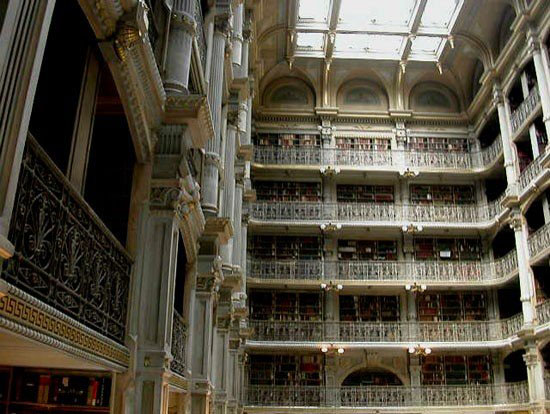
Originally intended to be a cultural center of Baltimore called the Peabody Institute Library, the George Peabody Library as it stands now is the research library of Johns Hopkins University. The library was a part of the Institute from 1878 until 1967, when it became owned by the city of Baltimore. It was eventually passed to Johns Hopkins in 1982, and is now where the university's special collections reside. Many of the collection's titles date back to the 19th century, and includes one of the world's foremost collections of Don Quixote editions. The building was described by the first Peabody provost as a "cathedral of books," featuring a 61-foot-high atrium, beautiful black and white marble flooring, numerous balconies, and golden columns.
27. Phillips Exeter Academy Library — Exeter, New Hampshire, USA
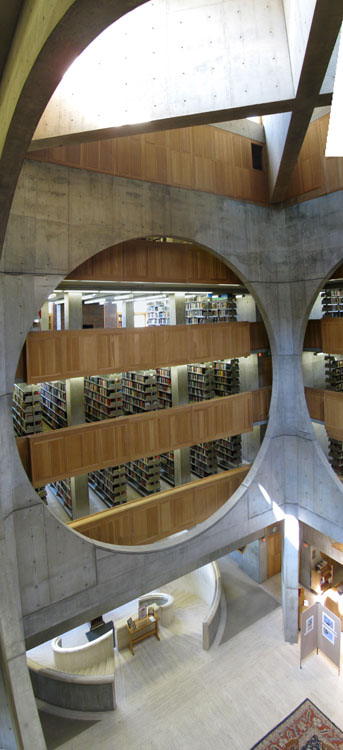
The Phillips Exeter Academy Library is the biggest library in the world when it comes to secondary school libraries. In a way, this is one of the most impressive libraries on our list for being merely a part of a prep school, albeit one of the wealthiest prep schools in the world. Designed by architect Louis Kahn, the the structure has won numerous architectural awards, including a Twenty-five Year Award by the American Institute of Architects, which is given to only one prestigious building each year. The library was even commemorated on a U.S. Postal Service stamp in 2005 as one of 12 stamp-worthy Masterworks of Modern American Architecture.
28. The Library of Alexandria — Alexandria, Egypt
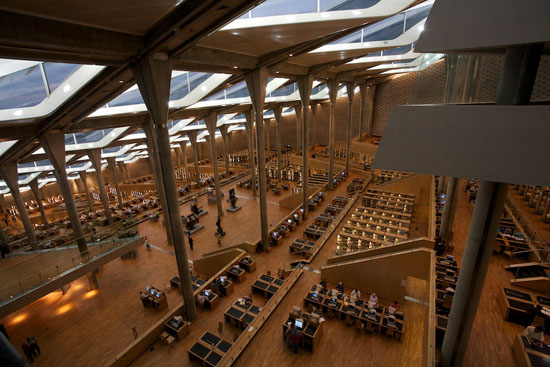
The Library of Alexandria was the ancient world's largest and most comprehensive library, housing books and manuscripts (on papyrus scrolls) as well as meeting rooms, gardens, and lecture halls on its grounds. Considered one of the Seven Wonders of the Ancient World, the original Library of Alexandria was tragically destroyed in a fire nearly 2,000 years ago. The new Library of Alexandria is a memorial to its predecessor. The Library cost $220 million to rebuild in 2002, and is now operating as not only a library, but also as a cultural center, planetarium, manuscript restoration lab, art gallery and exhibition space, museum, and conference center. Currently, the library contains more than 500,000 books, though it has space for over eight million.
29. Herzog August Library — Wolfenbüttel, Germany

Founded in 1572 by a German Duke, the Herzog August Library had become the largest library north of the Alps and one of the largest libraries in Europe by the 17th century. The library holds more than 900,000 books, more than a third of which were printed between the 15th and 18th centuries. Also called Bibliotheca Augusta, the library is internationally known for its extensive collection of books and manuscripts from the Middle Ages and early modern Europe.
30. José Vasconcelos Library — Mexico City, Mexico
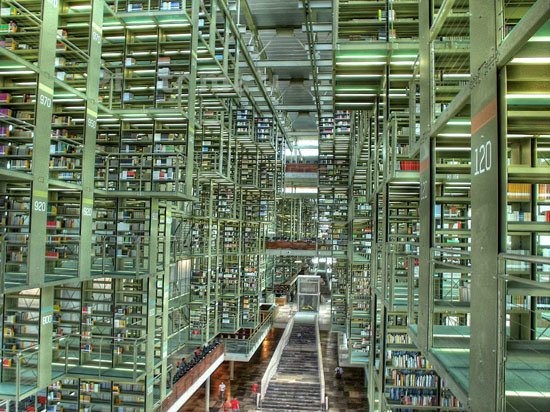
The José Vasconcelos Library, located in Mexico City, was called one of the most advanced constructions of the 21st century by former Mexican president Vicente Fox. The library cost nearly $100 million to build, and was the largest infrastructure investment for the Fox administration, with construction plans spanning 2000-2006. The library faced some stumbling blocks during its construction that eventually led to the library being closed for 22 months from 2007 until 2008; it has since been restored and was re-opened to the public. The open, scaffold-like shelving of the library is especially unique, as are the sculptures on site, including one by artist Gabriel Orozco made from a painted whale skeleton.
31. Rijksmuseum Library — Amsterdam, Netherlands

The Rijksmuseum Library is part of the Dutch National Museum in Amsterdam. One of the world's foremost libraries specializing in art and art history, the Rijksmuseum holds over 350,000 auction, exhibition, trade, and collection catalogues, in addition to numerous books and periodicals. Though the items on site have been collected since 1885, the library now also features an extensive online catalog with over 140,000 monographs, 20,000 art sale catalogs, and 3,200 magazines on display. The library is open to the public; while books and magazines are not available for check-out, they can be viewed in the reading room.
32. Stockholm Public Library — Stockholm, Sweden
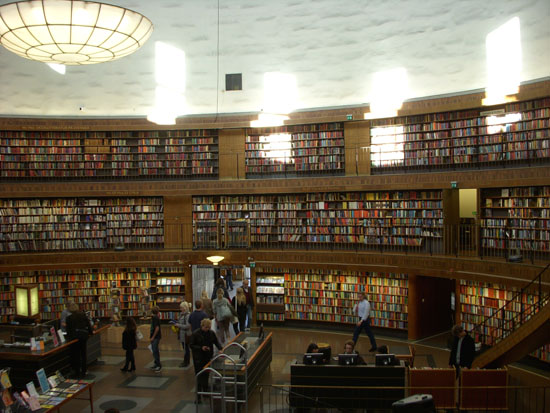
The Stockholm Public Library is one of the capital city's most notable buildings. Opened in 1928, the library was designed by Gunnar Asplund, one of the most important figures in Modernist Swedish architecture. The main interior of the building is a rotunda, giving visitors a pleasing view of many of the library's shelves along the curved rotunda walls. The Stockholm Public Library holds more than two million volumes and over 2.4 million audio visual and mixed media items.
33. The National Library of Singapore — Singapore, Singapore

The National Library of Singapore is now located in a 16-story building, constructed in 2005. Founded in the 1920s at the suggestion of Sir Stamford Raffles, "the father of modern Singapore," the original National Library was the first of its kind in Singapore, located in the same complex as the country's first school. Today, the library is home to more than 200,000 books and a performing arts center that can accommodate more than 600 guests. The building is adorned with multiple gardens, providing picturesque views of the city of Singapore.
34. University of Coimbra General Library — Coimbra, Portugal
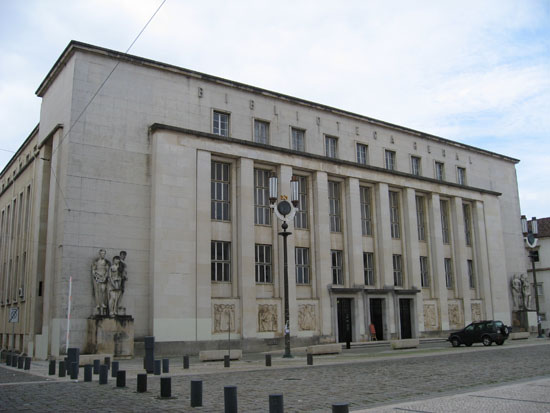
The University of Coimbra General Library has been in operation since the early 16th century in Portugal. Inventory for the library dating back to as early as 1513 shows that the library at the time already held more than 120 manuscripts. Officially established in 1537, the library today holds more than a million titles, with a separate building for historical pre-19th century books. Formally named the Biblioteca Joanina, the building's majestic Baroque architecture illustrates its 500-year history in Coimbra. The library is open daily to the public.
35. National Library — Minsk, Belarus
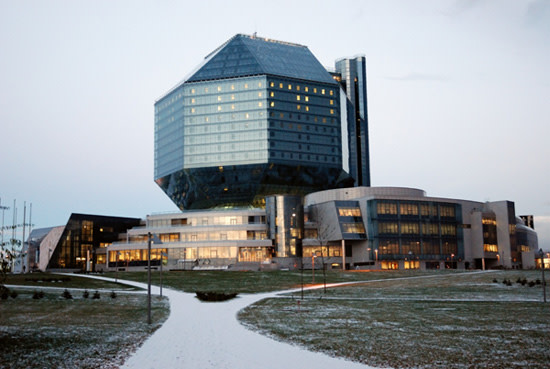
One of the best libraries in the world, and certainly one of the most distinctive and an architectural feat in its own right, the National Library of Belarus is shaped like a Rhombicuboctahedron (or this, for our fellow non-mathematicians). The unique 22-story building was opened in 2006, although the library has been in operation since 1922. The library is a tourist attraction and popular destination in Minsk, featuring a public observation deck and hosting public concerts on its lawn. As the official copyright library of Belarus, the National Library holds more than 8 million items, and houses the third largest collection of Russian works in the world.